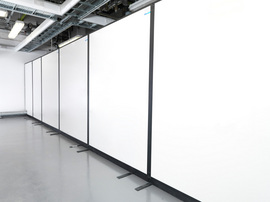 |
Date Announced: 09 Aug 2011
Lasermet are pleased to announce that the delivery and installation of its laser safety systems and equipment has been successfully completed at Imperial College London.
Lasermet manufactured to specification, supplied and installed a laser safety package which included laser blocking curtains, (both motorised and manual), laser enclosures, flat foot laser blocking screens and encapsulated laser blocking roller blinds. These are now all installed in the recently refurbished Thermofluids Division of the Mechanical Engineering Department located at South Kensington.
Flatfoot screens
The flatfoot screens installed are made from laser blocking material that is certified to withstand high powered laser beams in accordance with the relevant screen specification. As the name implies, the screens are kept upright using their flat feet. The screens are easily set up and can be moved within the lab environment to enable the relocation of test subject equipment such as engines and monitoring equipment.
Complete laser safety enclosure
Two large laser enclosures have been installed on site enabling high powered lasers to be used within the structures.
Most Class 4 and many Class 3B lasers present an eye hazard over very long distances and it is therefore imperative to have comprehensive laser safety protection in place wherever they are present. Laser radiation must be prevented from escaping through the windows of laboratories and production facilities.
Laser enclosure provides excellent versatility
The surrounding enclosure installed by Lasermet comprises of three laser blocking walls each 3m high. (The fourth wall is an existing structure). The space within one of the enclosures is divided into six rooms using Lasermet’s 2m tall flatfoot laser blocking screens. Each of these rooms can be used to run equipment using lasers being separate from the neighbouring room.
The second enclosure uses Lasermet’s laser blocking curtains to divide the enclosure into four quarters. Each curtain can be drawn back to produce one large room within the enclosure or, alternatively, each curtain can be drawn to the centre and zipped to the adjacent curtain. When two curtains are joined a new internal room is subsequently formed. If all four curtains are drawn to the centre then four separate rooms can be formed. Lasermet installed motorised and non-motorised versions of the curtains to maximise ease of use.
Curtains
Ordinary curtains or screens are rarely capable of stopping a laser beam and specially-designed blocking products are required, so Lasermet provided the laser blocking curtains to prevent any stray laser beam from reaching the windows of the building above the wall line of the laser enclosure. The college made use of the option to have motorised curtains enabling the easy drawing or opening of these curtains. Standard manual curtains were also installed.
These Laser-Blocking Curtains are made from Lasermet's specially-developed laser-blocking material and can be supplied ready-made as ceiling or wall-mounted curtains. The material is white on one side and black on the other side and will operate as a blackout screen as well as a laser-blocking screen. Both sides will block laser radiation but if the white side is used as the laser-blocking side a higher specification of blocking will be achieved, making it suitable for higher power lasers.
Laser blocking roller blinds
To complete the installation Lasermet provided encapsulated laser blocking roller blinds to enable the facility to be fully flexible. These blinds, fitted to cover smaller windows and door apertures in either motorised or manual versions, are made from the same Lasermet laser-blocking material as the curtains and are made-to-measure to fit any size of window. They are available as standard or encapsulated options. The roller blind is built into a white finish aluminium frame, which encapsulates the top, both edges and bottom of the blind. This eliminates any possibility of laser beams passing round the sides of the blind, blocks out all light and gives a much neater finish.
Laser based research in the Mechanical Engineering Department
The safety equipment installed enables the engineers to safely carry out their research into combustion on behalf of a number of internal combustion engine manufacturers. The researchers will be using lasers to monitor the combustion and the propagation of flame waves produced from engines. This forms part of the research into reducing exhaust gas emissions.
The Department of Mechanical Engineering at Imperial College London is one of the largest and most advanced departments in mechanical engineering in the UK. This Department sets out to extend the engineering science which underpins thermofluids and to advance the associated technology, with particular emphasis on the technical exploitation of fluid mechanics and thermodynamics for energy generation and its sustainable use.
More information is available on the Lasermet website.
http://www.lasermet.com/laser-safety-curtains-screens.php
E-mail: phil.jones@lasermet.com
Web Site: www.lasermet.com/laser-safety-curtains-screens.php
| © 2025 SPIE Europe |
|